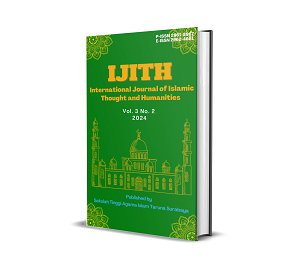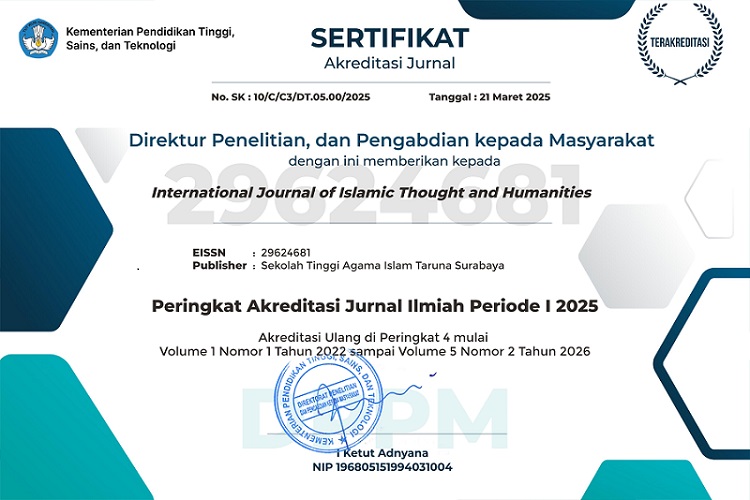Knitting Kauniyah and Qauliyah Verses: A Countenance Evaluation Study of the Trensains Program at Muhammadiyah Sragen Senior High School
DOI:
https://doi.org/10.54298/ijith.v3i2.515Keywords:
Evaluation, Trensains Program, Integrative EducationAbstract
Evaluative research is urgently needed to illustrate how Trensains is implemented in real-world contexts, particularly in educational institutions such as Muhammadiyah Senior High School in Sragen, which has adopted this approach. This study presents a unique approach by examining the integration of verses from kauniyah (the universe) and qauliyah (revelation/the Qur'an) in science learning. This study's novelty lies in applying the Countenance Stake evaluation model to assess the level of integration of Islamic values within the Trensains curriculum structure, which also represents a new contribution to the field of evaluating integrative science-based Islamic education. This research is an evaluative study with a descriptive-qualitative approach. The Countenance Evaluation Model developed by Stake was used to evaluate the program. The research location was Muhammadiyah Senior High School in Sragen, Central Java. This model examines program implementation through three main components, namely: (a) antecedents or initial context evaluation; (b) transactions that reflect the learning implementation process; and (c) outputs that evaluate the results of the process. The number of respondents was five teachers and three students. Implementing the Trensains program, which integrates science and divine revelation values, has significantly shaped students' conceptual understanding, analytical skills, and spiritual awareness. The learning strategy applied has led to a holistic scientific-spiritual approach. However, in its implementation, there are several obstacles, especially in the form of integration in the curriculum, especially in both fields, and strengthening the role of teachers as facilitators of integrated learning. Training in the integration of science and divine revelation values that is running has not been fully optimal due to limited understanding of the integrative approach, according to the field being developed, the lack of a comprehensive assessment rubric, and the lack of systemic support in terms of facilities and cross-subject collaboration.
Downloads
References
Aithal, P. S., & Srinivasan, R. (2025). Envisioning a Scientific, Sustainable, Holistic, Spiritual and All-rounded Indian School Education System as per NEP 2020, Inspired by Sanathana Dharma. SSRN Electronic Journal. doi:10.2139/ssrn.5192591
Arifin, Z., & Aji Nugroho, M. (2025). Modernisation of Islamic Religious Education Learning Based on Science at SMA Trensains Muhammadiyah Sragen: Ismail Raji Al-Faruqi’s Perspective. Proceeding International Conference On Islam, Law, And Society.
Ayyusufi, A. M., Anshori, A., & Muthoifin, M. (2022). Evaluation of The CIPP Model on The Tahfidz Program in Islamic Boarding Schools. Nazhruna: Jurnal Pendidikan Islam, 5(2), 466–484. doi:10.31538/nzh.v5i2.2230
Council, N. R., Earth and Life Studies, D. on, Life Science, B. on, & Key Challenge Areas for Convergence and Health, C. on. (n.d.). Convergence: Facilitating Transdisciplinary Integration of Life Sciences, Physical Sciences, Engineering, and Beyond. DC: The National Academies Press.
Fardyatullail, H., Arif, S., & Heemphinit, Z. (2023). The Idea of Islamization: A Study of Imam Suprayogo’s Thought. TAJDID, 22(1), 1–24.
Hanif, A., Wahyudin, W., & Sholahuddin, S. (2025). Implementation of Transdisciplinary Approaches in Islamic Education to Face Contemporary Global Challenges. Eduprof : Islamic Education Journal, 6(2), 151–171. doi:10.47453/eduprof.v6i2.283
Horn, A., Visser, M. W., Pittens, C. A. C. M., Urias, E., Zweekhorst, M. B. M., & Van Dijk, G. M. (2024). Transdisciplinary learning trajectories: Developing action and attitude in interplay. Humanities and Social Sciences Communications, 11(1), 149. doi:10.1057/s41599-023-02541-w
Jannah, N., Nawangsari, D., Ubaidillah, U., & Hepni, H. (2025). Theoretical Implications for the Core Knowledge of Islamic Religious Education in the Disruptive Era. FALASIFA : Jurnal Studi Keislaman, 16(01), 48–60. doi:10.62097/falasifa.v16i01.2163
Munadi, M. (2016). Integration of Islam and Science: Study of Two Science Pesantrens (Trensain) in Jombang and Sragen. Jurnal Pendidikan Islam, 5(2), 287. doi:10.14421/jpi.2016.52.287-303
Nadirah, S. (2023). Reimagining Islamic Scholarship: Integrating Psychology, Gender, and Public Policy. Sinergi International Journal of Islamic Studies, 1(3), 128–142. doi:10.61194/ijis.v1i3.594
Ningsih, T., Purnomo, S., Muflihah, M., & Wijayanti, D. (2022). Integration of Science and Religion in Value Education. IJORER : International Journal of Recent Educational Research, 3(5), 569–583. doi:10.46245/ijorer.v3i5.248
Nufus, D. H., Sururin, S., & Sodiq, A. (2023). Tafakkur: A Contemplation of Students’ Spiritual and Emotional Intelligence (in The Perspective of Sufism & Transpersonal Psychology). DAYAH: Journal of Islamic Education, 6(2), 264. doi:10.22373/jie.v6i2.18957
Palah, S., Wasliman, I., Sauri, S., & Andriana Gaffar, M. (2022). Principal Strategic Management In Improving The Quality Of Education. International Journal of Educational Research & Social Sciences, 3(5), 2041–2051. doi:10.51601/ijersc.v3i5.497
Srinio, F., Muslihun, & Umair Khan Usman, M. (2025). Comparison of Islamic and Western Education Systems: Opportunities for Integration of Islamic Values. Adiluhung: Journal of Islamic Value and Civilization, 2(1), 29–41. doi: 10.59373/adiluhung.v2i1.114
Sukmono, F. G., & Kencana, A. P. S. (2023). Development of Digital Competence Through Mobile Journalism at Trensains Muhammadiyah Senior High School, Sragen. Proceeding International Conference of Community Service, 1(1), 333–339. doi:10.18196/iccs.v1i1.72
Suyadi, S., Susilowati, S., & Supriyatno, T. (2021). Islamic Character Education for Student of Public Higher Education in Indonesia: International Conference on Engineering, Technology and Social Science (ICONETOS 2020), Malang, East Java, Indonesia. doi:10.2991/assehr.k.210421.086
Wiśniewska, M. Z., & Grudowski, P. (2024). The culture of excellence and its dimensions in higher education. The TQM Journal, 36(2), 593–615. doi:10.1108/TQM-11-2022-0325
Yachina, N. (2015). The Problem of Spiritual and Moral Formation of Personality. Procedia - Social and Behavioral Sciences, 197, 1575–1579. doi:10.1016/j.sbspro.2015.07.113
Ziegler, M., Danay, E., Heene, M., Asendorpf, J., & Bühner, M. (2012). Openness, fluid intelligence, and crystallized intelligence: Toward an integrative model. Journal of Research in Personality, 46(2), 173–183. doi: 10.1016/j.jrp.2012.01.002
Downloads
Published
How to Cite
Issue
Section
License
Copyright (c) 2024 Nur Rachmaningtyas, Azaki Khoiruddin, Hanif Cahyo Adi Kistoro

This work is licensed under a Creative Commons Attribution-ShareAlike 4.0 International License.
Authors who publish with this journal agree to the following terms:
- Authors retain copyright and grant the journal right of first publication with the work simultaneously licensed under a Creative Commons Attribution-ShareAlike 4.0 that allows others to share the work with an acknowledgement of the work's authorship and initial publication in this journal.
- Authors are able to enter into separate, additional contractual arrangements for the non-exclusive distribution of the journal's published version of the work (e.g., post it to an institutional repository or publish it in a book), with an acknowledgement of its initial publication in this journal.
- Authors are permitted and encouraged to post their work online (e.g., in institutional repositories or on their website) prior to and during the submission process, as it can lead to productive exchanges, as well as earlier and greater citation of published work (See The Effect of Open Access).


















